With the NHL player lockout having now moved beyond the realm of mere probability into cold, hard fact, hockey fans are likely to be on the hunt for any kind of hockey they can find between now and next year. On the video game front, both Visual Concepts and EA are once again adding new installments to their yearly NHL franchises. ESPN NHL 2K5, Visual Concepts' title, came out on the PlayStation 2 and Xbox earlier this month and proved to be a phenomenal game of hockey. NHL 2005, EA's newest hockey title, looks fantastic, but it doesn't quite compare in terms of its actual hockey gameplay. Sure, the game definitely improves upon certain aspects of last year's NHL 2004, but in other key areas, the game suffers from some occasionally overambitious artificial intelligence and restrictive game design that ultimately makes the game more frustrating than it probably should be. Make no mistake. This is still a solid game of hockey, but it isn't the most realistic or best-playing NHL title out there, and as such, it shouldn't be your first choice for one.
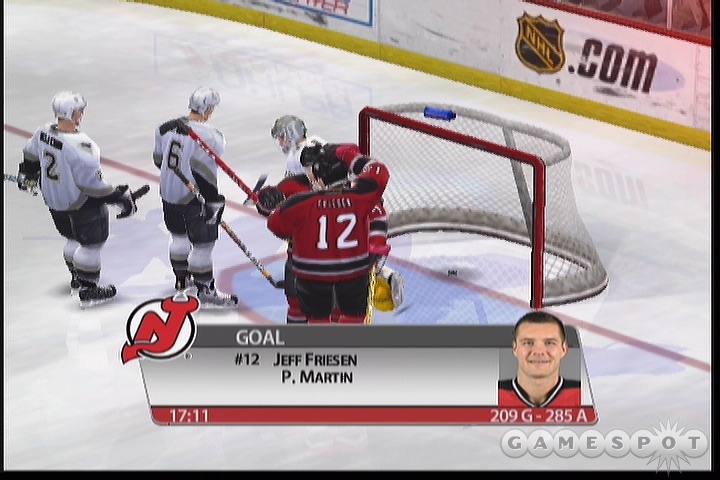
If you played NHL 2004, you'll notice a few subtle but useful control tweaks in this year's game. The first and perhaps most important one is the separation of slap shots and wrist shots into two separate buttons. Other games have given you ways to control exactly what kinds of shot you wanted to send toward the net, but this method is by far the easiest. Now, if you want to send a blistering slap shot from the point on command, you can. And if you want to get in close to the net to send a wrister up top-shelf, you can do that too. NHL 2005 also features a brand-new wraparound shot that is far more like the type of quick wraparounds you would see in a real NHL game. Just press one of the shot buttons while behind the net, and your player will try to push the puck into the corner of the net. If you played the last Midway-produced NHL title, NHL Hitz Pro, you may recognize this exact same shot from that game. However, just because EA didn't invent it doesn't make it a bad idea. So, in fact, it's an immensely useful addition.
Another useful control change is the ability to shift control to a player that isn't in possession of the puck when on offense. By pressing a button, you'll then be in control of another forward while the player in control of the puck moves up-ice. Position yourself correctly and you'll be in line for a quick one-timer. The one downside to this mechanic is that the camera always stays trained on the player who's controlling the puck, so it can sometimes be hard to get a bearing on the controlled player's position. However, once you get the hang of it, this mechanic becomes pretty indispensable.
One big gameplay fix from last year's game is the whole passing system. NHL 2005 still has the same basic two-button passing system from last year, but it's been polished up to fix some of the problems people had with passes just missing to the left or right. The puck still doesn't just automatically go to the closest player's stick, but passing is generally a lot more accurate and easier to manage, so you're far less likely to whiff on what should be an easy and clear pass.
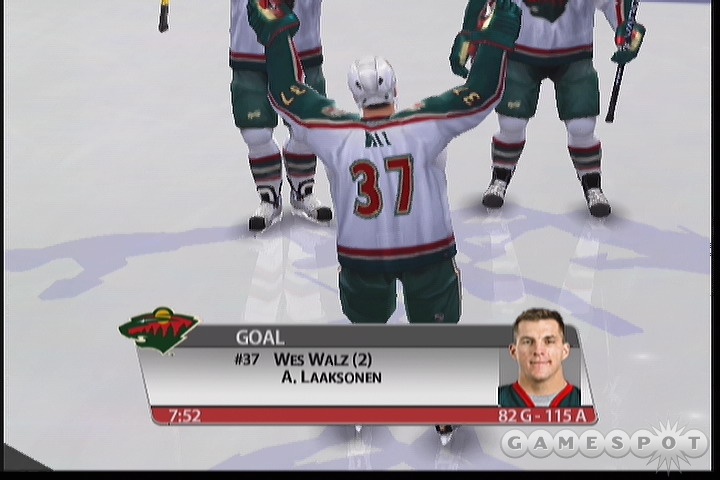
EA Chicago has also gone to great lengths to fix some of the offensive bunching issues found in last year's game. Forwards and defensemen on the offensive side of the puck are much better about spreading out in the offensive zone, giving you better chances to set up real plays. However, it could be said that sometimes forwards give you almost too much space. This is especially noticeable when moving through the neutral zone to cross over into the offensive zone. Typically, unless your line is specifically set to crash the net, your line mates will hang a bit too far back, which often leads to you being all by yourself in the zone for at least a few seconds. Normally this wouldn't be too much of a problem, but thanks to the game's overzealous defensive AI, it does become an issue.
No doubt, the defense in NHL 2005 is tough--almost too tough, actually. Basically, getting a breakaway in this game is a near impossibility on any difficulty but the easiest--at least until you've spent quite a lot of time trying to master the various deke moves and speed burst timings. If you're up against even a decently rated defensive pairing, you're likely to get knocked flat on your face before you even get within 10 feet of the net, which typically results in a quick turnover. The defensive AI doesn't even seem to really use the poke-check mechanic inside the offensive zone much at all. This is primarily because it much prefers to just lay you out flat on the ice every single time you get anywhere near the goal. While this might seem like it would make a game a penalty-filled affair, it actually doesn't. In fact, on the default settings, penalties almost never get called at all.
The game's overabundance of checking appears courtesy of a fix that the developer added to help improve checking. Last year, one complaint that players voiced involved the fact that most of the checks in the game seemed more like varying degrees of shoves than anything else. Now you can deliver absolutely brutal hip checks and similarly vengeful moves with the right amount of momentum. Of course, the problem with this is that the team on defense always seems to find a way to hit you with almost maximum momentum, which gives you no time to get behind the net or do anything else you might normally do to try to set up a one-timer. This isn't as much of a problem if you're up against a smaller forward or one of the few less-than-tough defensemen out there, but more often than not, you're going to go down. Basically, your best bet is to get as close as you think you can to the net without getting waylaid so that you can throw a hard slap shot at the net and then hope one of your teammates gets in close enough to throw his stick at the possible rebound if the shot doesn't go in immediately. This is not to say that you will do this every time you get into the offensive zone, but you will find yourself doing this a fair amount--at least early on in your time spent with the game.
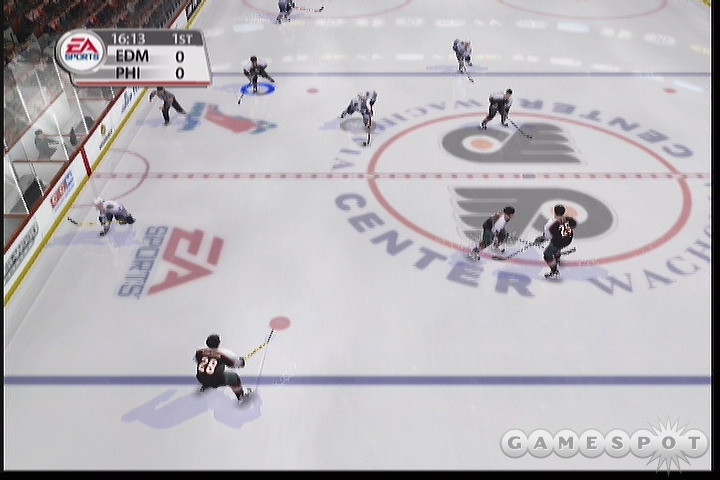
What's even crazier about this is that in actuality, you don't even really need to worry about setting up plays to begin with--at least not on the default difficulty. More often than not, if you time a big slap shot just right--and if the goalie is anything less than Brodeur-esque in quality--you'll be able to score at least three or four goals a game. Well, why not just bump up the difficulty then? Simply put, because the medium and hardest difficulty settings are absolutely brutal when it comes to defense. Remember all that checking and getting knocked to the ice on the default setting? Multiply that by at least two for every difficulty notch you increase to, which will eventually bring you to a point where it actually looks like defensemen are being sucked into your player. Essentially, there just isn't a very good balance between difficulty levels. The game isn't impossible, by any means, but the overly check-happy defense does make the game a lot more frustrating than it needs to be--especially if you're someone who likes to play a more strategic game.
With all of that said, however, NHL 2005 is still quite a fun game to play, even if it isn't always especially realistic. The speed of the game is excellently paced, making for a fast and furious game of hockey each time out, and aside from some of the previously mentioned issues, the AI typically behaves very well by reacting accordingly when you actually do manage to get a good play set up. It also manages to react very well to some of the coaching setups you can design, like how you can make each line perform a different kind of offense that ranges from crashing the net to working the puck from behind the net. At least the AI does so once all your forwards decide to finally traipse their ways into the zone. The gameplay, as a whole, is a lot of fun, provided you're willing to accept some of the game's less realistic aspects to just appreciate it for what it is--a fast, fun game of hockey.
In terms of game features, NHL 2005 isn't the deepest game you'll ever find, but it's got its share of modes to keep you busy. This year's dynasty mode is definitely where the most developmental effort has gone. However, in some ways, it's also the least attractive of what NHL 2005 has to offer. Most all of the elements from last year's dynasty mode have made their ways into this year's game, including team upgrades and the ever-popular player morale system. The biggest new addition is essentially the factor that drives the whole mode: owner objectives. In the real-life NHL, every team has different goals and objectives. If you're playing for a team like Colorado, ambition and winning a Stanley Cup presents a huge part of what drives your franchise forward. But, if you're on a team like the Chicago Blackhawks, your goals are far more financially driven. So the second it looks like you're not turning a profit, there's hell to pay. NHL 2005 emulates this variation of team goals by ranking each team in three categories: ambition, team, and profit. Ambitious teams want to both make the playoffs and win the cup; team-oriented franchises are loyal to their players and typically stick with the most loyal players, regardless of record or money; and profit-driven teams just want to be in the green at the end of every season, plain and simple.
Depending on what kind of team you pick, you'll have one specific objective handed down to you by the team owner at the start of the season. For example, if you pick the Devils, the owner will want you to make it to the conference finals, and if you choose the Blackhawks, your goal will be to obtain the number one draft pick (no matter what). With each goal, you'll have only two seasons in which to accomplish your mandated tasks. There is most definitely a degree of realism to be found in a setup like this, but in a way, it also sucks a lot of the fun out of the whole process. A big part of the appeal of a dynasty is the chance for a player to take a team that might not be so good and do whatever it takes to take that team to the top. However, the player may just want to take a favorite team and make them dominant, regardless of starting quality. With this mode, you can't really do that--at least not quickly. If your favorite team happens to be one that wants to aim high, then you're in luck. But, if you happen to be a Blackhawks fan, you may not want to wade through however many seasons it takes to make your profit-hungry owner happy enough to finally let you start making your team legitimately successful. Maybe if this whole aspect were optional, that would be one thing, but, sadly, it isn't.
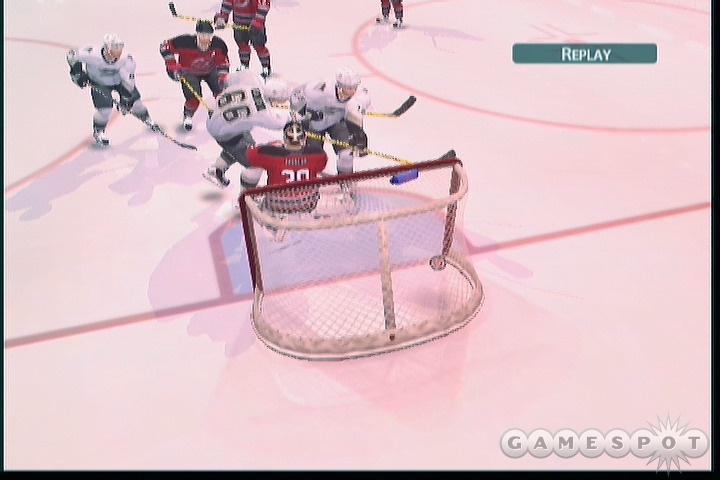
Outside of the whole objective system, there are some other additions that bear mentioning. One of these is the new line-chemistry mechanic. Let's face it: There's far more to making a successful line in hockey than just throwing three good players together. In the case of NHL 2005, each forward and defenseman belongs to one of three categories. Forwards consist of scorers, playmakers, and grinders, while defensemen consist of players who are offensive-minded, defensive-minded, or checkers. Ideally, your goal is to try to mix up the lines as much as possible so that each type of player is represented on each line. Mixing a playmaker and a pair of scorers or a scorer and a grinder is a far better solution than sticking three scorers on a line. This system works pretty well, and it definitely forces you to think about how you will fill your roster when free agency and the draft come around. Unfortunately, it can also be kind of a pain as well.
The irritating aspect of the chemistry system comes from issues pertaining to how each season is simulated. You typically will be simming most of your games from the game's season schedule section, which shows all of your upcoming games. However, when a player gets injured or is otherwise incapacitated, the simulation doesn't stop to let you know that this has happened. Instead, the game will just set up its own lines based on what it thinks is best and will keep them that way until you stop simulating long enough to check your e-mail, where you'll see an injury report from however long ago. Were the lines that the game picked for you at least sensible, then there would be no problem with this. However, about half the time, the game will pick some of the most harebrained lines imaginable (Paul Kariya on a fourth line? What?). Outside of this issue, the chemistry system really does work noticeably well. It's just a shame that you have to micromanage it so closely during your dynasty.
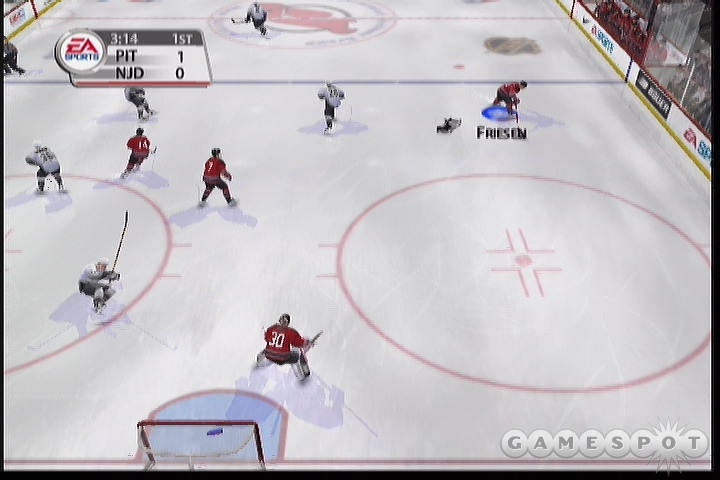
Poorly autopicked lines and a lack of during-simulation notification aren't the dynasty mode's only problematic aspects. The last and perhaps silliest issue belongs squarely in the realm of the offseason. NHL 2005 has no real progressive offseason to speak of. Rather, you just sim through the offseason calendar until you eventually happen upon the draft, where you blindly pick rookies using info that varies in accuracy depending on the quality of your scouting staff. While this isn't very interesting, what's perhaps dumbest of all is that there aren't even the right number of rounds in the draft. There are only five, to be exact.
Once you get past the draft, July 1 comes, and the free agency period starts. And this is where the biggest oversight of the game occurs. You see, NHL 2005 has no real free agency negotiation component. Once free agency begins, you can just cherry-pick your way through all of the best players (assuming your owner won't freak out about your roster expenses). No free agent ever even entertains another offer, unless you lowball him too badly, at which point he just won't negotiate with you for the rest of the year if he rejects three of your offers. But, provided you're willing to pony up the dough, you can basically steal all the best players without any other team ever interfering. This sort of offseason management used to be the norm, but standards have changed, and, at this point, it all just seems pretty lazy by comparison.
But, hey, the dynasty mode isn't all bad. One of the best aspects of this year's dynasty mode is a part that we weren't totally sold on last year: the team upgrades system. Basically, as you win games and progress through each season, you'll earn money for your upgrade budget, which you can spend on a host of on-ice and off-ice upgrades that range from better travel arrangements (which increase player stats for road games) to better assistant general managers (who can help increase the likelihood of a trade being accepted). There's a much wider variety of upgrades this year, and also, unlike last year's game (where your team started out badly lacking in terms of stats due to a shortage of upgrade points at the beginning), this year's game presents no immediate pressure to upgrade your team heavily, because your team starts out about where it should in year one. The only negative aspect about the upgrades is that eventually they become just a little bit too effective, causing your team to almost overperform, to a degree. While this definitely bodes well for your record, it kills a bit of the game's statistical realism.
NHL 2005 also includes a fully revamped practice scheduling system, since last year's system was more than a little cumbersome. Now you can basically set up specific types of practices that benefit specific statistics for your players. Light workouts benefit breakout and morale stats, whereas full-contact practices gear up your team's defense and checking. While this is definitely better than last year's erratic practice scheduling, there also isn't a whole lot do it. You don't set up particular days for practice, so, presumably, it all just happens automatically. It might have been nice had EA added a little more management to the practices beyond just allowing you to select a practice and then leaving it be until you feel like changing it. However, as it is, what's here works well enough.
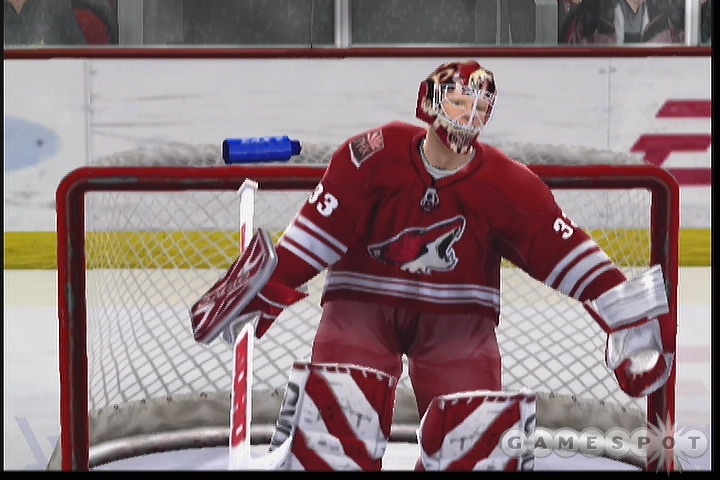
When it comes right down to it, NHL 2005's dynasty mode has several enjoyable components, but, ultimately, it feels poorly balanced. It seems like a lot of fundamental things just kind of got left on the drawing board, and what ended up in the final game simply doesn't feel like a fully realized mode. It's solid enough to entertain those who might want something a little different from their dynasty modes than the typical fare, but if you're stringent about your dynasty mode quality, you'll probably find this one more than a little flustering.
As any true hockey fan knows, this year was the year of the World Cup of Hockey, and in NHL 2005, you have the opportunity to play through the whole tournament in the World Cup mode. All eight of the tournament's international teams are featured with fully accurate rosters. Additionally, if you pick a team with more available players in the game from that team's country, at the beginning of the mode, you can replace any players you please, letting you design the ultimate international team. In a sense, this mode is really just kind of a glorified tournament mode, but considering how big of a deal this year's World Cup turned out to be, it's very cool being able to play the tournament properly, in addition to having the opportunity to earn a big cup--and a winning celebration at the end of it all.
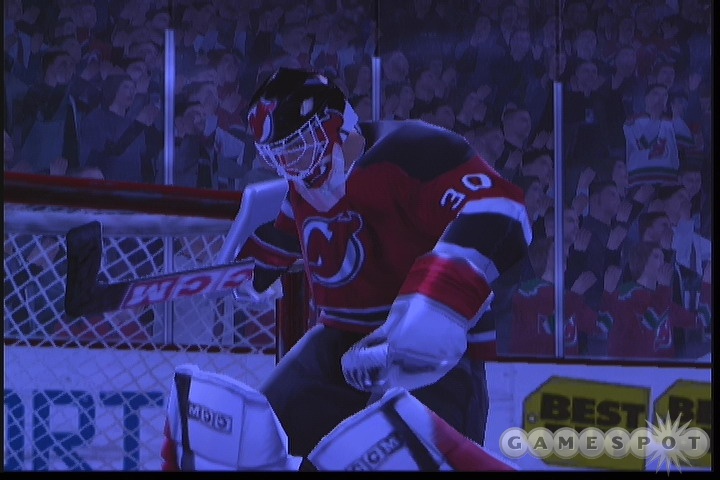
The only other new mode addition in NHL 2005 is the Free4All mode. This is basically a quirky, little minigame where up to four players occupy the same section of ice while all trying to score on the same goalie in an every-man-for-himself style of play. There are a couple of rule options you can set, such as whether you're playing to a certain number of goals or are just trying to score as many goals as possible within an allotted time frame. You can also throw a defenseman or two into the mix to try to counteract your scoring chances. No doubt, Free4All is a fun mode, and it's very fun, in fact. However, it does lack lasting playability, because it's just one minigame. So when you consider that the competing NHL title, ESPN NHL 2K5, has 15 different minigames to choose from--all of which can be played online (while Free4All, incidentally, can't)--Free4All seems a tad pale in comparison.
Speaking of online, the Xbox, PS2, and PC versions of NHL 2005 are all online this year. Unfortunately, that's about all you can say for them, because, while they are online, the online functionality in all three versions is pretty sad. The two console online modes feature basic head-to-head play, leaderboards, friends lists, and other typical options. The actual online performances leave more than a little to be desired, however. Under a variety of broadband conditions, both the PS2 and Xbox versions suffered from some pretty bad lag that resulted in a lot of mistimed shots and checks. Furthermore, every action seemed to be at least a half second behind each button press. The PS2 version also suffered from some nasty frame rate chop online. The PC version has all the types of online functionality found in last year's game, so there's head-to-head play, tournaments, and online clubs to play with, as well as the EA Messenger and leaderboards. The PC version is a little bit better about the lag, but it suffers from the same brand of ugly frame rate chop that the PS2 version suffers from.
The differences between the three versions of the game, beyond the online capabilities, are pretty slight, but there are a few. Graphically, all three console versions of NHL 2005 look as you would expect, with the Xbox version offering the most graphical polish and the PS2 version offering the least. Both the PS2 and GameCube versions also suffer from a bit of in-game frame rate drop, which the Xbox version seems to be devoid of. The PC version definitely trumps all of the console versions in terms of graphical quality, but it doesn't always control as well. We tried a couple of different dual analog gamepads, and, generally, the control sensitivity always seemed a bit too loose, even when we messed around with the settings. It still plays well on the PC, but the game definitely seems better suited for a console.
NHL 2005's visuals are probably its strongest asset. It's readily apparent from the get-go that a whole lot of development time went into further improving last year's excellent player models. The most detail is found in the faces, which are absolutely amazing--and not just in the facial mapping either (though that aspect is pretty incredible by itself). Even the animation used for facial expressions that are seen during cutscenes is really something else. NHL 2005 also contains fully modeled coaches for the first time, and they look really good. Compare John Tortarella in real life to his in-game counterpart and you'll see what we mean. The on-ice animation is better than last year's game, though not by leaps and bounds. Checking is definitely improved in terms of sheer brutality, and there are a few nice, new goalie animations. Otherwise, it looks like pretty standard stuff.
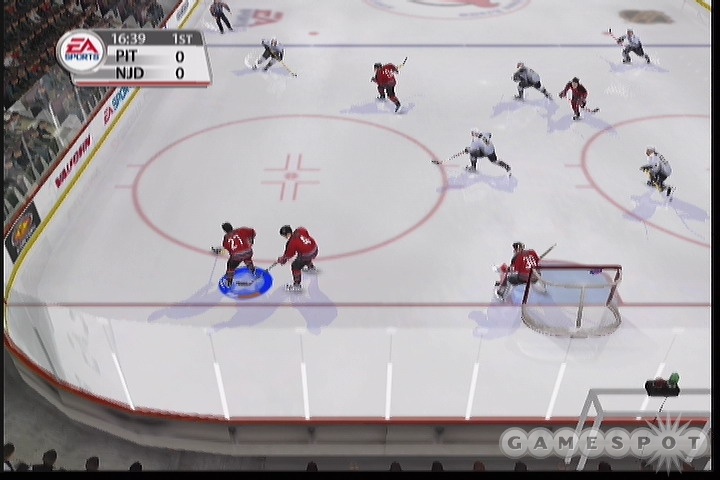
On the flip side, sound is the category where NHL 2005 fares the least well. The commentary duo of Jim Hughson and Craig Simpson is back for another year, and between the two of them, the commentary is pretty unspectacular. Much of Hughson's lines seem like retreads of previous years, and Simpson rarely ever interjects himself enough to make any sort of impact. The game's soundtrack consists of the usual EA Trax mishmash of bands. However, there is only a very short list of songs (only nine to be exact), and at least a couple of them are repeated songs from the Madden NFL 2005 soundtrack. Furthermore, the Xbox version doesn't even support custom soundtracks, which is just plain sad. On the plus side, the on-the-ice action sounds plenty good, but that's really the only aspect of the game's audio that comes across well.
In many ways, NHL 2005 comes off as something of a halfhearted effort. The game looks and plays as slickly as ever, but there are more than a few aspects of the game that seem like they were just kind of thrown together. In the end, while NHL 2005 is most certainly still a very good game overall, any NHL fan hoping for improvement over last year's offering is going to be pretty disappointed.